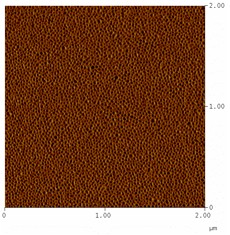Nanoporous thin films
Until now, the
methods used for the preparation of nanoporous materials from block
copolymers are based on chemical, UV or plasma degradation of the
minor block of the copolymer. These methods have the disadvantage
to be irreversible and to lead to pores with uncontrolled chemical
functionalities at the walls. A controlled chemical functionality
on the pore walls could however be extremely interesting to create
selective membranes or sensors.
We are developing block copolymers with cleavable junctions between
the blocks as starting materials for the formation of nanoporous
membranes. More precisely, our strategy is based on the use of
diblock copolymer in which the junction between the blocks is a
cleavable metal-ligand complex or a photocleavable
derivative.
Among the different morphologies that can be obtained from block
copolymers, the cylindrical morphology is of particular interest
since it can be transformed into an array of nanopores after
elimination of the minor component (see scheme 1). To exploit the
full potential of those block copolymers, the cylindrical
microdomain orientation has to be controlled. An orientation normal
to the substrate is particularly desirable. The main reported
methods to achieve this target require the use of external fields
such as electric fields, controlled interfacial interactions, and
solvent evaporation. Very recently, we found that copolymer
containing a cleavable charged metal-ligand complex at the block
junction directly led to a perpendicular orientation of the
cylinders without the need of any further treatment.

General
strategy leading to functionalized nanoporous thin films. The
cleavable copolymer is first self-assembled as a thin film with a
cylindrical morphology (a). The appropriate stimulus is applied in
order to cleave the copolymer and the minor block is eliminated by
washing with a selective solvent (b).

AFM
phase image of a film of cleavable metallo-supramolecular copolymer
spin-coated from a benzene solution.
Two
different synthetic strategies are investigated to prepare
these cleavable copolymers: the post-functionalization of
end-reactive polymer blocks or the use of a polymerization
initiator already functionalized with (part of) the cleavable
junction. Controlled radical polymerization techniques (ATRP, RAFT and
NMP processes) are used to reach theses goals.
Researchers involved: Pierre Guillet, Jean-Marc Schumers, Clément Mugémana
Collaborations:
Ulrich Schubert
(Eindhoven), Alain Jonas (UCL), Tom Russell (Amherst)
Relevant
papers:
"Nanoporous thin films from self-assembled metallo-supramolecular
block copolymers"
C. A. Fustin, B. G. G. Lohmeijer, A.-S. Duwez, A. M. Jonas, U. S.
Schubert, J.-F. Gohy
Adv.
Mater.
2005, 17,
1162-1165
"Comparing the self-assembly of metallo-supramolecular and covalent
block copolymers"
C.-A. Fustin, M. J. Misner, T. P. Russell, P. Guillet, B. G. G.
Lohmeijer, U. S. Schubert, J.-F. Gohy
Polym.
Mater. Sci. & Eng.
2006, 95,
49-50